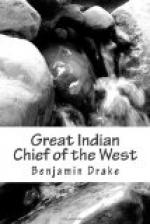The land on which St. Louis stands, as well as the surrounding country, was claimed by the Illini confederacy, which had acquiesced in the intrusion of the whites. This circumstance, it is supposed, led the northern confederacy to the attempt, which they made in 1779, to destroy the village of St. Louis, then occupied by the Spaniards. As the Sacs and Foxes were active participators in this attack, no apology is necessary for introducing the following graphic account of it, from the pen of Wilson Primm, Esqr. of St. Louis.[2]
“In the mean time numerous bands of the Indians living on the lakes and the Mississippi—the Ojibeways, Menomonies, Winnebagoes, Sioux, Sacs, &c. together with a large number of Canadians, amounting in all to upwards of fourteen hundred, had assembled on the eastern shore of the Mississippi, a little above St. Louis, awaiting the sixth of May, the day fixed for the attack. The fifth of May was the feast of Corpus Christi, a day highly venerated by the inhabitants, who were all Catholics. Had the assault taken place then, it would have been fatal to them, for, after divine service, all the men, women and children had flocked to the prairie to gather strawberries, which were that season very abundant and fine. The town being left perfectly unguarded, could have been taken with ease, and the unsuspecting inhabitants, who were roaming about in search of fruit, have been massacred without resistance. Fortunately, however, a few only of the enemy had crossed the river and ambushed themselves in the prairie. The villagers, frequently came so near them, in the course of the day, that the Indians from their places of concealment, could have reached them with their hands. But they knew not how many of the whites were still remaining in the town, and in the absence of their co-adjutors, feared to attack, lest their preconcerted plan might be defeated.”




